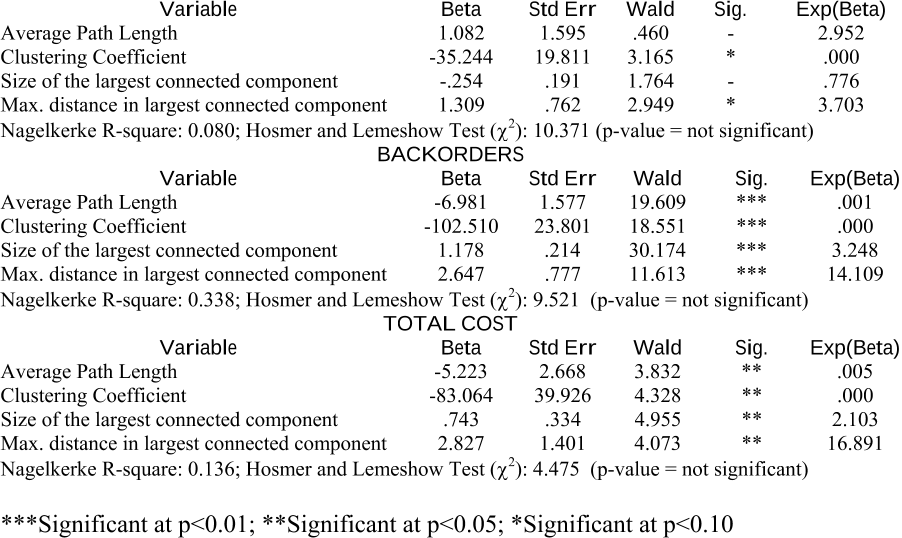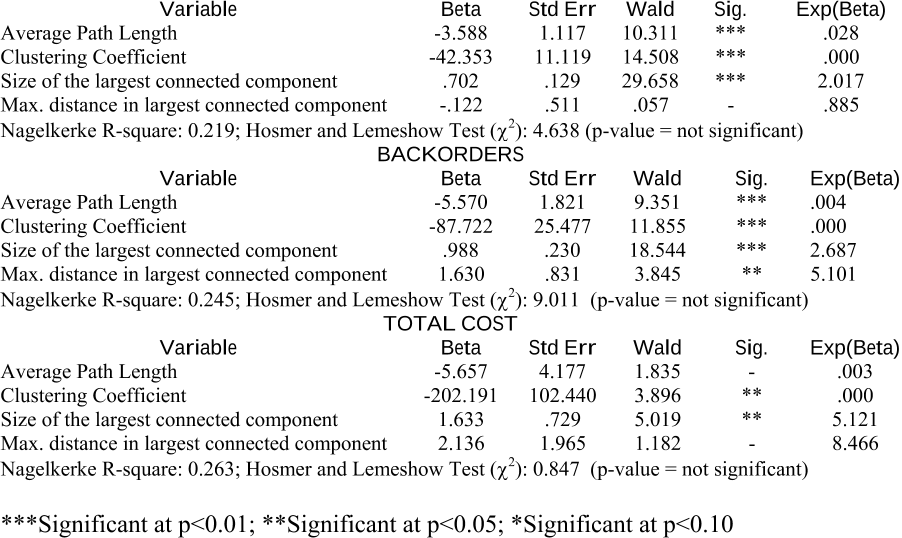
1
SUPPLY NETWORK TOPOLOGY AND ROBUSTNESS AGAINST
DISRUPTIONS – AN INVESTIGATION USING MULTIAGENT MODEL
Anand Nair *
Department of Management Science
Moore School of Business
University of South Carolina
Columbia, SC - 29208, USA
Phone: (803) 777-2648
Fax: (803) 777-3064
E-mail: nair@moore.sc.edu
José M. Vidal
Department of Computer Science and Engineering
Swearingen Engineering Center
University of South Carolina
Columbia, SC - 29208, USA
Phone: (803) 777-0928
Fax: (803) 777-3767
E-mail: vidal@sc.edu
* Corresponding Author
(Forthcoming)
International Journal of Production Research

2
Supply Network Topology and Robustness against Disruptions – an
investigation using multiagent model
In this study we examine the relationship between supply network’s topology and its robustness
in the presence of random failures and targeted attacks. The agent based model developed in this
paper uses the basic framework and parameters in the experimental game presented in Sterman
(1989) for modeling adaptive managerial decision making in an inventory management context.
The study extends the linear supply chain context to a complex supply network and undertakes a
rigorous examination of robustness of these supply networks that are characterized by distinct
network characteristics. We theorize that network characteristics such as average path length,
clustering coefficient, size of the largest connected component in the network and the maximum
distance between nodes in the largest connected component are related to the robustness of
supply networks, and test the research hypotheses using data from several simulation runs.
Simulations were carried out using twenty distinct network topologies where ten of these
topologies were generated using preferential attachment approach (based on the theory of scale-
free networks) and the remaining ten topologies were generated using random attachment
approach (using random graph theory as a foundation). These twenty supply networks were
subjected to random demand and their performances were evaluated by considering varying
probabilities of random failures of nodes and targeted attacks on nodes. We also consider the
severity of these disruptions by considering the downtime of the affected nodes. Using the data
collected from a series of simulation experiments, we test the research hypotheses by means of
binomial logistic regression analysis. The results point towards a significant association between
network characteristics and supply network robustness assessed using multiple performance
measures. We discuss the implications of the study and present directions for future research.
Keywords: Supply networks, Topology, Disruptions, Robustness, Scale-free Networks, Random
Networks, Agent-based model, Binomial Logistics Regression
Introduction
In recent times, supply disruptions are receiving considerable managerial attention due to
their adverse impact on organizational performance. Sheffi and Rice (2005) highlight the
supply chain implication of the terrorist attack on September 11, 2001 by giving the
examples of adverse effect on Ford’s and Toyota’s operations. Chozick (2007) report that
70% of Japan's auto production was temporarily paralyzed for a week due to the
disruptions in the supply of piston ring caused by a 6.8-magnitude earthquake that hit
central Japan thereby damaging Riken Corp.’s production plant, the supplier that makes
custom piston rings for most of the car makers in Japan.

3
The increased interest in supply chain disruptions is also evident in research
studies. For instance, studies have examined the financial implications of supply chain
disruptions (e.g., Hendricks & Singhal, 2003; 2005) and investigated risk mitigation and
contingency planning strategies in the presence of supply chain disruptions (e.g. Sodhi,
2005; Tomlin, 2006). There is also a growing research stream that examines disruption
and related supply chain issues by using a multiagent-based simulation framework (e.g.
Thadakamalla et al., 2004).
Our paper fits within this multiagent based approach. In this study we examine
how supply network topology is associated with its robustness in the event of disruptions.
It has been observed that several supply networks exhibit incredible robustness in the
presence of disruptions while others fail to survive random failures or targeted attacks.
Sheffi and Rice (2005) provide examples of firms, whose supply networks are
characteristically distinct from each other, making their levels of resilience and
robustness to random failures and targeted attacks to be considerably different. This study
builds on the extant literature in statistical physics that examine the error and attack
tolerance of complex networks (Albert et al., 2000; Thadakamalla et al., 2004), and
consider the impact of supply network characteristics, such as average path length,
clustering coefficient, size of the largest connected component, and maximum distance
between two nodes in the largest connected component, on performance measured in
terms of inventory levels, backorders and total costs within a supply network.
Literature review and research hypotheses

4
Modeling of complex networks has focused on three main classes: (i) random graphs:
these variants of Erdős – Rényi model (Erdős and Rényi, 1959; Bollobás, 1985) are still
widely used in many fields and serve as a benchmark for many modeling and empirical
studies; (ii) small-world models: these models interpolate between the highly clustered
regular lattices and random graphs; and (iii) scale-free models (Barabási and Albert,
1999): these are motivated by the power-law degree distribution of the nodes in complex
networks as evident in several networks such as the World Wide Web (Albert et al.,
1999), the Internet (Faloutsos et al., 1999), or metabolic networks (Jeong et al., 2000).
When viewed from the perspective of robustness to failures, it is observed that random
networks and small-world networks have similar properties due to the similarity in their
degree distribution (Thadakamalla et al., 2004). Meanwhile, scale-free networks are
highly robust to random failures but are sensitive to targeted attacks. Thus, random
networks and scale-free networks present two characteristically distinct topologies, a
systematic examination of which can provide deeper insights regarding the association of
network characteristics with its robustness against disruptions.
Studies, such as Albert et al. (2000), have focused on random graphs and scale-
free network topologies to discern the error and attack tolerances of these networks.
Consistent with this stream of research and with literature emphasizing that supply
networks follow topologies commonly observed in complex adaptive systems (Surana et
al., 2005; Sun and Wu, 2005; Pathak et al., 2007; Wang et al., 2008; Bichou et al., 2007),
in this paper we consider random and scale-free network topologies for our research
investigation of robustness of supply networks.

5
The theory of random networks has its origin in the use of probability methods in
problems related to graph theory. Erdős and Rényi (1959) define a random graph to be
one in which N nodes are connected to n edges, chosen randomly from N(N-1)/2 possible
edges. There are
n
NN
C
]2/)1([ −
possible graphs that can be formed with all graphs having
equal probability of being realized in the probability space. The theory of random graphs
concerns with an examination of this probability space as
∞
→N .
The scale-free networks were motivated from a mismatch between the clustering
coefficients found in real-world network and those predicted by random graphs. Also, it
has been observed that even for those networks for which P(k) (a distribution function
representing the probability that a randomly selected node has exactly k edges) has an
exponential tail, the degree distribution do not follow Poisson distribution as suggested in
random graphs theory. Barabási and Albert (1999) present the idea of scale-free network
by considering the power-law degree distribution that is observed in several real world
networks. The networks grow by continuous addition of new nodes. Instead of following
a random-attachment of nodes, these networks follow a preferential attachment logic
whereby new nodes join a node that is already highly connected (i.e. exhibit high degree).
Formally, the probability Π that a new node n will connect to a node i in the network
depends on the degree k
i
of node i:
∑
=Π
j
j
i
i
k
k
k )(.
Further details on the analytical and empirical developments in the random graphs
and scale-free network theory are presented in Albert and Barabasi (2000) and
Dorogovtsev and Mendes (2002). In the following subsections we present details
regarding network characteristics that are used for our research investigation.




